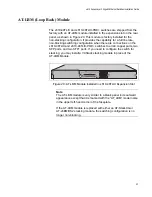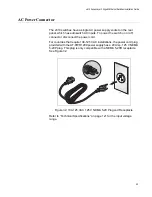
Chapter 1: Overview
56
Power Over Ethernet Plus (PoE+)
The following section applies to x610-24Ts-POE+, x610-24Ts/X-POE+,
x610-48Ts-POE+ and x610-48Ts/X-POE+ Gigabit Ethernet switches only.
The 10/100/1000Base-T ports on these switches feature Power over
Ethernet (PoE), defined in the IEEE 802.3af standard, and Power over
Ethernet Plus (PoE+), defined in the IEEE 802.3at standard.
PoE+ is a mechanism for supplying power to network devices over the
same twisted pair cables used to carry network traffic. Power is injected on
the Ethernet cabling along with data by Power Sourcing Equipment (PSE),
like an Ethernet LAN switch or router. A device that receives its power
over an Ethernet cable is called a Powered Device (PD).
The switch automatically determines whether or not a device connected to
a port is a PD. A PD has a signature resistor or capacitor that the switch
can detect over the Ethernet cabling. If the resistor or capacitor is present,
the switch assumes that the device is a PD.
Once a PD is discovered, a PSE may optionally perform PD classification
by applying a DC voltage to the port. If the PD supports optional power
classification it will apply a load to the line to indicate to the PSE the
classification the device requires.
For more detailed information about PoE+ see the latest release of the
AlliedWare Plus
Operating System Software Reference Guide
.
Power Classes
Since PDs may require differing power ranges, the IEEE 802.3at Power
Ethernet standards classifies PDs according to their power consumption.
By providing the PSE with its power range, the PD allows the PSE to
supply power with greater efficiency. The power classes as outlined by
IEEE 802.3at are as follows, showing the different PD classes and the
PSE power output for each corresponding PD power range:
Table 12. Class vs. Power Levels
PD Class
Maximum Power Level
Output at the PD
*
Maximum Power Level
Output at the PSE
0
0.44W to 12.95W
15.4W
1
0.44W to 3.84W
4.0W
2
3.84W to 6.49W
7.0W
3
6.49W to 12.95W
15.4W
4
12.95W to 25.5W
30W
















































